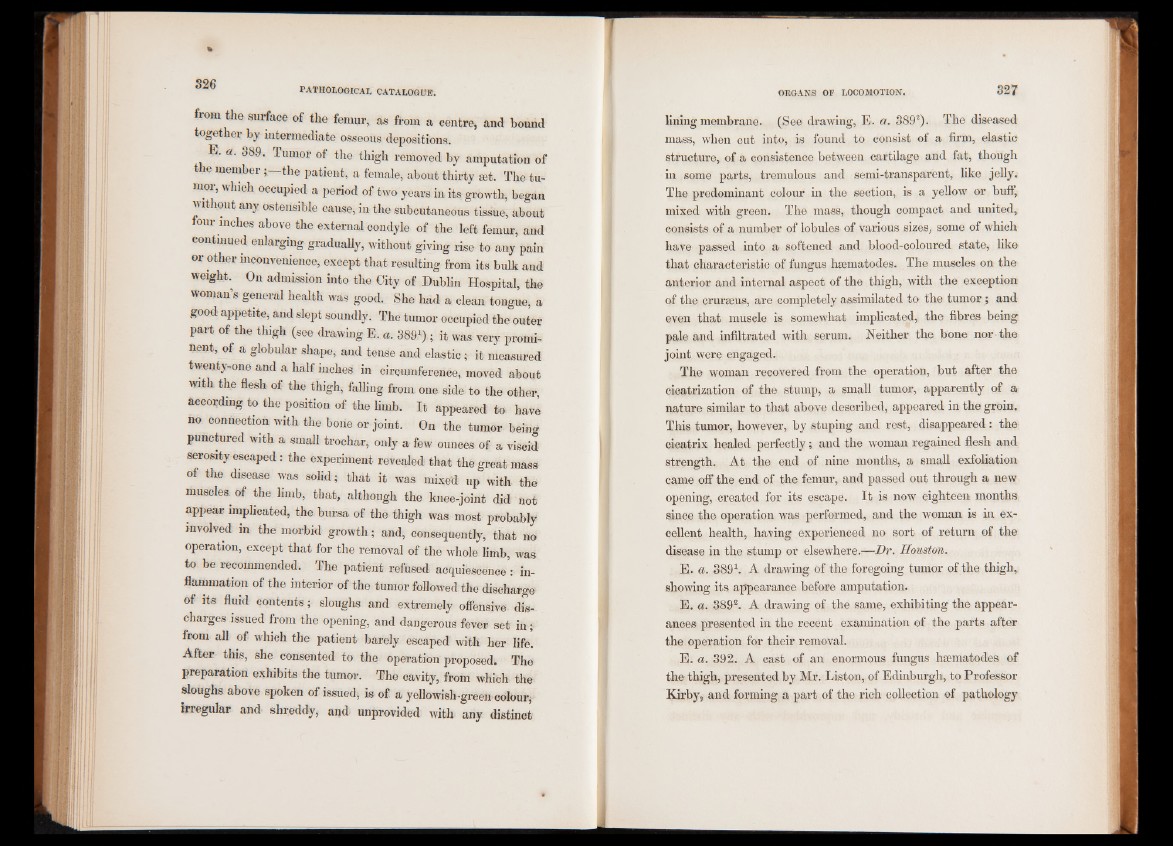
from the surface of the femur, as from a centre, and bound
together by intermediate osseous depositions.
E. a. 389. Tumor of the thigh removed by amputation of
t ie member the patient, a female, about thirty æt. The tumor,
winch occupied a period of two years in its growth, began
without any ostensible cause, in the subcutaneous tissue, about
our inches above the external condyle of the left femur, and
continued enlarging gradually, without giving rise to any pain
or other inconvenience, except that resulting from its bulle and
weight. On admission into the City of Dublin Hospital, the
woman’s general health was good. She had a clean tongue, a
good appetite, and slept soundly. The tumor occupied the outer
part of the thigh (see drawing E. a. 3891) ; it was very prominent,
of a globular shape, and tense and elastic ; it measured
twenty-one and a half inches in circumference, moved about
with the flesh of the thigh, falling from one side to the other
according to the position of the limb. It appeared to have
no connection with the bone or joint. On the tumor being
punctured with a small trochar, only a few ounces of a viscid
serosity escaped : the experiment revealed that the great mass
of the disease was solid; that it was mixed up with the
muscles, of the limb, that, although the knee-joint did not
appear implicated, the bursa of the thigh was most probably
involved in the morbid growth ; and, consequently, that no
operation, except that for the removal of the whole limb, was
to be recommended. The patient refused acquiescence’: inflammation
of the interior of the tumor followed the discharge
of its fluid contents ; sloughs and extremely offensive discharges
issued from the opening, and dangerous fever set in •
from all of which the patient barely escaped with her life.
After this, she consented to the operation proposed. The
preparation exhibits the tumor. The cavity, from which the
sloughs above spoken of issued; is of a yellowish-green colour;
Irregular and shreddy, and unprovided with any distinct
lining membrane. (See drawing, E. a. 3892). The diseased
mass, when cut into, is found to consist of a firm, elastic
structure, of a consistence between cartilage and fat, though
in some parts, tremulous and semi-transparent, like jelly.
The predominant colour in the section, is a yellow or buff,
mixed with green. The mass, though compact and united,
consists of a number of lobules of various sizes, some of which
have passed into a softened and blood-coloured state, like
that characteristic of fungus hsematodes. The muscles on the
anterior and internal aspect of the thigh, with the exception
of the crurseus, are completely assimilated to the tumor; and
even that muscle is somewhat implicated, the fibres being
pale and infiltrated with serum. Neither the bone nor the
joint were engaged.
The woman recovered from the operation, but after the
cicatrization of the stump, a small tumor, apparently of a
nature similar to that above described, appeared in the groin.
This tumor, however, by stuping and rest, disappeared: the
cicatrix healed perfectly; and the woman regained flesh and
strength. At the end of nine months, a small exfoliation
came off the end of the femur, and passed out through a new
opening, created for its escape. It is now eighteen months
since the operation was performed, and the woman is in excellent
health, having experienced no sort of return of the
disease in the stump or elsewhere.—Dr. Houston.
E. a. 3891. A drawing of the foregoing tumor of the thigh,
showing its appearance before amputation.
E. a. 3892. A drawing of the same, exhibiting the appearances
presented in the recent examination of the parts after
the operation for their removal.
E. a. 392. A cast of an enormous fungus hDematodes of
the thigh, presented by Mr. Liston, of Edinburgh, to Professor
Kirby, and forming a part of the rich collection of pathology